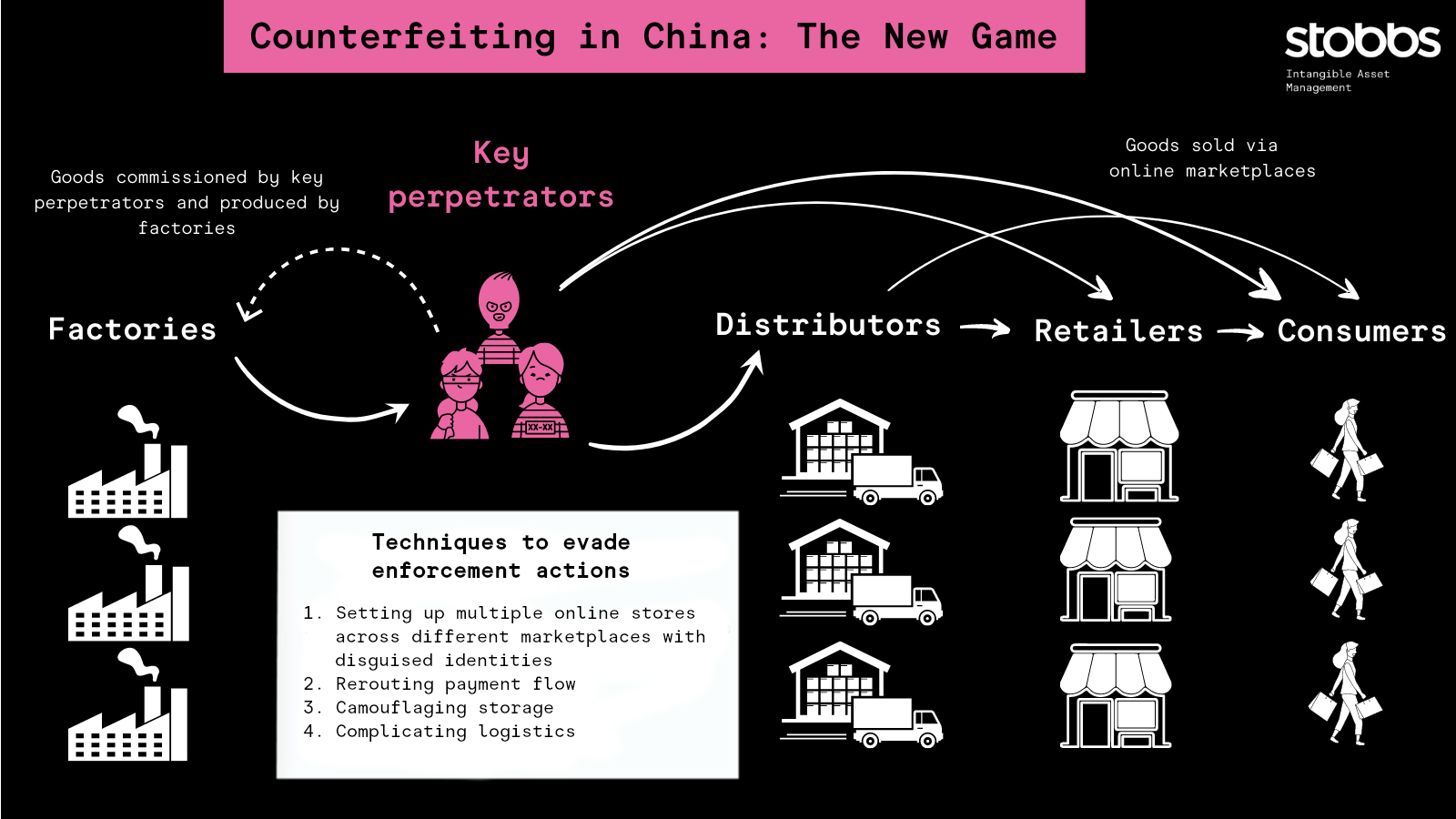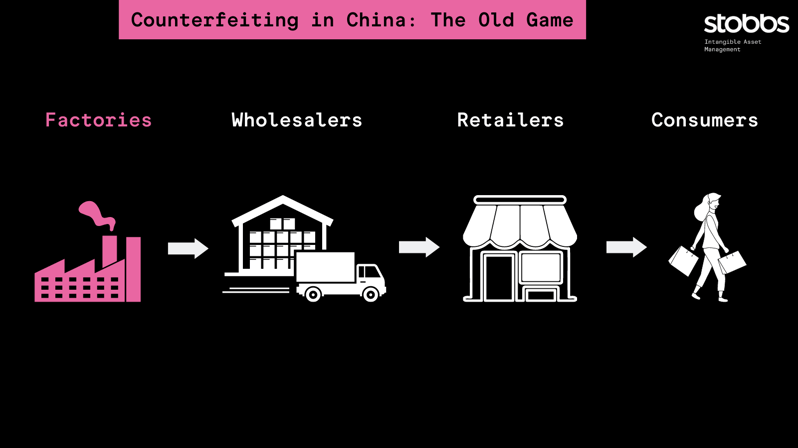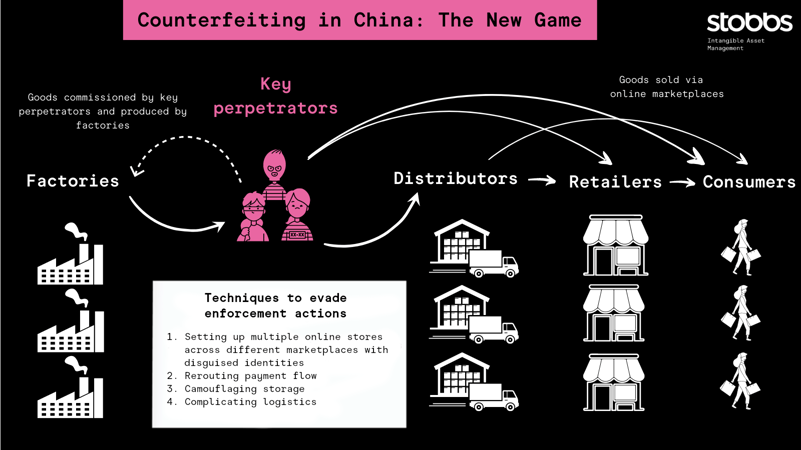
It was never simple, but at least it was straightforward
Before the rise of e-commerce, counterfeiting operations were predominantly led by factory owners. They determined the types of products to counterfeit and distributed the goods to local wholesalers or trading companies, who then exported the goods from China to global markets. Brand owners could disrupt these straight-line supply chains relatively easily by targeting the manufacturers, thus cutting off the counterfeiting activity at the source.

Today, the counterfeiting landscape is infinitely more complex
The landscape has fundamentally changed – the “straight line” approach will rarely succeed in today’s environment where big online sellers control the pace and direction of counterfeiting in China. These players are well-informed about social media trends and leverage their influence on consumer purchasing behaviour. They commission multiple factories to counterfeit products in demand and undercut wholesalers by setting up many online accounts to market, distribute or even export the counterfeit products B2B and B2C via marketplaces. This results in a complex counterfeiting ecosystem, dotted with multiple manufacturing sources and a web of distributors of different sizes, who may also double up as retailers.
The source of the counterfeiting is difficult to determine – and if feels like fighting the Hydra; cutting off one head means that two grow back.

This complexity is shaped by four separate levers
To complicate the situation further, these big online sellers have engineered sophisticated ways of evading brand enforcement actions:
(i) Setting up multiple online stores across different marketplaces with disguised identities
Counterfeiters hold many identity cards (either stolen or borrowed from their friends and family) and SIM cards (which can easily be obtained from the black market) to create multiple accounts in online marketplaces.
On B2B platforms like 1688.com, they redirect buyers from the platform chats to their personal WeChat to complete sales, thereby removing reliance on marketplaces as intermediaries and erasing sales records to avoid satisfying China’s criminal threshold (we’ll explain more about this further below).
They are also ready to create a new account whenever one is suspended, and often achieve verified seller status within a short time. They do this by engaging in “Shua Dan”; an illegal but widespread practice in China to manipulate online traffic, make fake purchases and forge user reviews to boost visibility of the new accounts on marketplaces. This misleads consumers into thinking that they are legitimate, credible sellers.
(ii) Rerouting the payment flow
Chinese criminal law sets monetary thresholds for pursuing criminal liabilities against counterfeiters: RMB50,000 for producing counterfeit goods and RMB150,000 for reselling counterfeit goods.
To avoid satisfying the thresholds, counterfeiters direct their earnings to different third-party bank accounts, digital wallets and/or use tools like POS machines to transfer the funds away in cash.
This does not only make them ‘untouchable’ legally, but also further conceals the identities of the key perpetrators to make enforcement against them much more difficult.
(iii) Camouflaging storage and mis-directing raids
To minimise the risk of raids, counterfeit goods are delivered and stored in different warehouses away from the factories as soon as they are manufactured. Counterfeiters sublet or short let their warehouses, so they change their storage facilities often and quickly when tipped off. Some even store the goods with independent storage providers or in the warehouses of marketplaces.
Drop-shipping has also become increasingly common so counterfeiters do not need to be responsible for storage, and instead simply have the goods shipped to consumers directly by a third party. This further enhances their distributing and retailing network while producing a new layer of defence against raids and enforcement actions by local authorities.
(iv) Complicating logistics
To confuse investigations, goods may be sent to accomplices in different cities or countries before they are forwarded on to consumers.
This is why, for example, many counterfeit products detained at Customs both in and outside of Mainland China are consignments from Hong Kong or other cities, when in fact they originate from the Mainland.
The perpetrators also use transhipment hubs for their shipping addresses and courier lockers for their return addresses, both of which tend to lead to dead ends in investigations – an anti-counterfeit expert would often not advise investigating these.
Failing to adapt and adjust means that old-world techniques are fundamentally ineffective
Old tactics for outdated supply chains are no longer effective. Brand owners are pouring even more money and time into what seems like a bottomless pit, hoping their outdated and flawed tactics will still apply in a whole new game.
In addition to wasting money and resources on ineffectual actions, poorly-directed enforcement can make things even worse – by complicating investigations and tipping off counterfeiters.
Brand owners are then often dragged into a game of whack-a-mole, where:
- Online listings re-surface after takedowns;
- Field investigation teams are routed to fake addresses; and
- New production facilities continue to pop up despite raids.
The work of brand owners, their legal teams and the investigations teams are all wasted, and the long-term damage to the brands themselves can be potentially irreparable.
Today’s complex counterfeiting landscape can be navigated
It doesn’t have to be this way. With the right capability and approach, it is possible to minimise the impact of counterfeiters and protect your brands.
At Stobbs, we believe that anti-counterfeiting issues should be viewed not only through a legal lens but also a practical and commercial one. As the counterfeiting landscape in China evolves, we too have developed strong proprietary knowledge and undercover capabilities to elicit information from counterfeiters and to decode complex supply chains. Whilst you can’t predict the actions of the counterfeiters, you can actively minimise their impact – by nipping their activities in the bud, and ensuring they stay away for longer before trying again.
Case Study – from navigating the landscape to where X marks the spot
Last year, Stobbs supported one of our Consumer Electronics clients in building a deep knowledge of Chinese counterfeiting supply chains. We analysed their online brand monitoring data and conducted offline investigations, mapping the linkages among parties, and learning their work patterns.
The exercise uncovered a criminal group who had been manufacturing, distributing, and exporting a particular counterfeit model of their brand. They had access to an extensive and sophisticated network of co-conspirators, and the key perpetrators had multiple countermeasures in place to minimise the risks of being cornered.
We enlisted the help of key local authorities to circumvent these countermeasures, singled out the key perpetrators, and successfully disrupted their operations with a series of raids. Our approach resulted in a seizure of $300,000 worth of goods on the spot and uncovered a further $1.6 million worth of transactions relating to the counterfeit sales of our client’s products.
The case was a huge success. The whole supply chain was broken up, and defence mechanisms were built to make it difficult for the offenders to repeat their operations in the future.
Each counterfeiting network is different – requiring a bespoke approach for every circumstance
At Stobbs, we believe that all enforcement actions must be tailored to the counterfeiting operations that the brand owners are targeting.
We have a network of anti-counterfeiting investigators and local lawyers throughout Asia.
With a breadth of options at our fingertips, we are best positioned to resolve these integrated, cross-border anti-counterfeiting operations.
If you are thinking about these two questions:
- Do I have a counterfeit issue, and on what scale?
- And how can I resolve it?
Please reach out to Michelle Phua, the head of our Asia Anti-Counterfeiting desk, to discuss how we can help create a bespoke solution for your needs.
Send us your thoughts:
Would you like to read more articles like this?
Building 1000
Cambridge Research Park
CB25 9PD
Fax. 01223 425258
info@iamstobbs.com
Privacy policy
German office legal notice
Cookie Declaration
Complaints Policy
Copyright © 2022 Stobbs IP
Registered Office: Building 1000, Cambridge Research Park, Cambridge, CB25 9PD.
VAT Number 155 4670 01.
Stobbs (IP) Limited and its directors and employees who are registered UK trade mark attorneys are regulated by IPReg www.ipreg.org.uk

